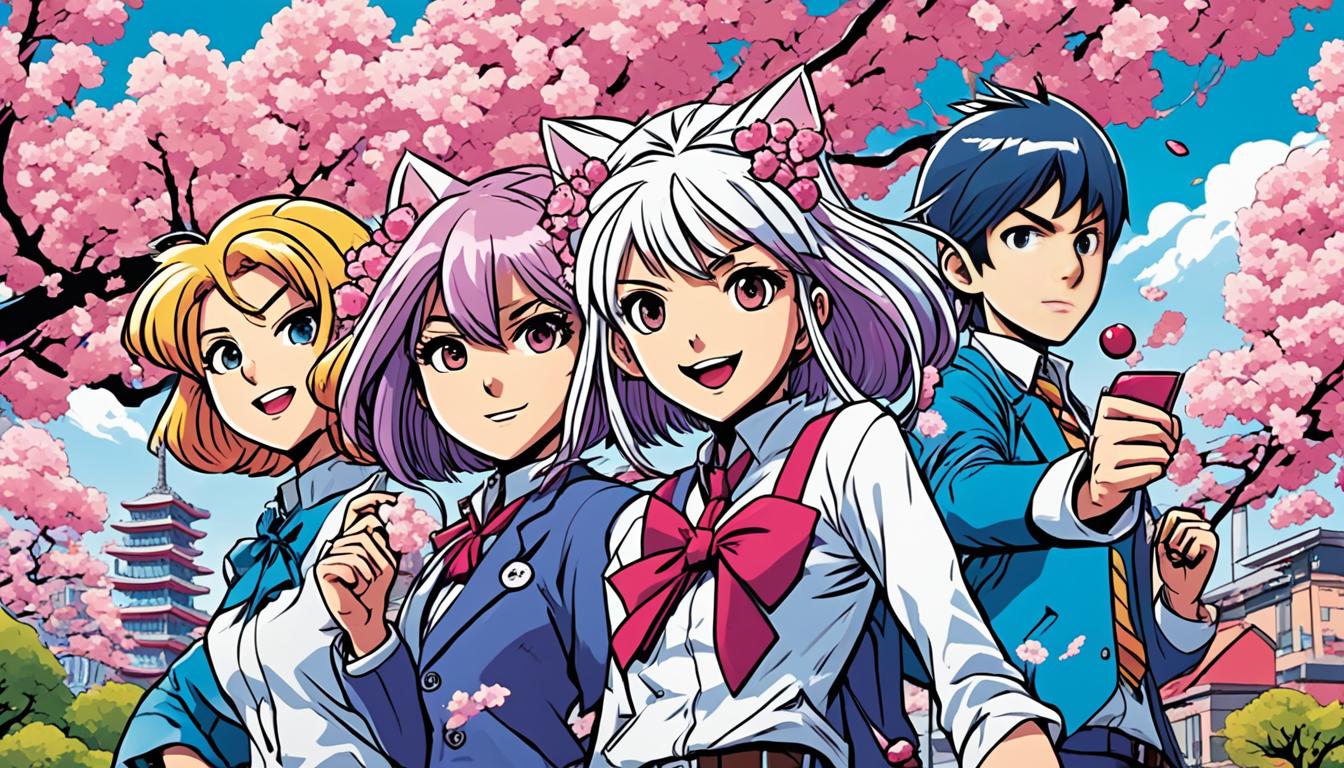Anime and manga are awesome for Japanese language learning. They not only entertain you but also deepen your cultural understanding. Whether you’re new to the language or almost fluent, they’re a fun way to learn.
Key Takeaways:
- Anime and manga originated in Japan and cover a vast array of genres, appealing to a wide audience.
- Popular series like “One Piece,” “The Apothecary Diaries,” “Beastars,” and “Horimiya” offer opportunities to practice Japanese language skills.
- Streaming platforms like Crunchyroll and Netflix provide subtitle options in multiple languages for various anime and manga series.
- Amazon offers manga in English for several recommended titles, available in Kindle and paperback versions.
- Combining anime watching with other learning resources like textbooks and language exchange partners is recommended for a comprehensive Japanese learning experience.
Watching anime and reading manga can boost your Japanese skills, no matter your level. By enjoying your favorite stories, you’ll learn new words and phrases. You’ll also understand different ways Japanese people speak. This makes learning feel more like fun than work.
Anime and manga let you peek into Japan’s culture and daily life. They help you learn about Japanese traditions and customs. This enriches your language learning and cultural understanding at the same time.
Using anime and manga to learn Japanese is great, but don’t forget other tools. Books, online classes, talking to native speakers, and visiting Japan can all help. They make your learning experience complete.
Excited to learn more? Next, we’ll look at how anime and manga platforms help you learn Japanese. We’ll also suggest series that fit your interests, whether you like action, romance, or comedy. There’s a story waiting to show you the wonders of the Japanese language.
The Purpose of Anime and Manga Learning Platforms
Anime and manga have fans across the globe and learning Japanese has spiked in interest. Now, fans and those learning can dive into anime and manga and learn Japanese at the same time. It’s fun and educational for everyone.
These platforms have a wide selection. Netflix, Amazon Prime Video, and Crunchyroll host many shows. This makes it easy for learners to watch from anywhere and anytime.
For those starting to learn Japanese, children’s anime is a good start. Shows like Pokémon and Sailor Moon are great. They have simple language and fun stories. This helps new learners pick up basic vocabulary and grammar.
One useful technique is called language shadowing. By reading subtitles out loud while watching, you can improve speaking and listening. This helps with pronunciation and understanding spoken Japanese better.
But, not all anime is good for learning the language. Some, like sci-fi and fantasy, might use complex language. It’s better to watch genres that show everyday life, like high school or sports. This way, you can learn everyday, practical Japanese.
“Japanese is an honorific language with distinct ways of communication based on the relationship between speakers. It is essential to understand the context when learning from anime.”
Japanese language depends a lot on honorifics. This means how you speak depends on who you’re talking to. Anime shows these different ways of speaking, which is important to notice while learning. This helps in understanding when to use formal or informal language.
It’s not enough to learn Japanese just from anime. It’s best to use anime as an extra source. Combine watching with other methods, like courses, books, or talking with native speakers. This gives a more well-rounded learning experience.
Effectiveness of Anime for Language Learning
Watching anime with subtitles can really help improve language skills. Students who watched English anime with English subs improved their scores by 17%. But, when they watched without subs, their scores improved by only 7%. Surprisingly, watching with Spanish subtitles didn’t help.
This was also true for English TV dramas for Spanish students. Watching without subtitles led to a 17% score increase, compared to 7% with subtitles. Similarly, Spanish subtitles with English shows had no effect on scores.
These studies show anime can be a great learning tool. It’s useful for improving listening and speaking, as well as grammar and vocabulary. It also exposes learners to different language styles and cultural elements.
Next, we’ll look at how to find the best anime and manga for starting your Japanese learning.
Learning Japanese through Anime and Manga
Anime and manga are not just fun; they’re great aids for learning Japanese. Whether you’re just starting or mid-way, they make studying language fun and immersive.
Watching anime or reading manga in Japanese shows you different language styles and real-life talk. This includes everyday words, slang, and how different people talk to each other.
It’s not just fun; it’s good for your ears too. By following the conversations, you get better at understanding and speaking Japanese. It’s like an extra language practice.
You learn a lot of new words and ways to speak in Japanese from watching or reading. Keep a notebook handy for jotting down new phrases. This really boosts your vocabulary.
Plus, you get really good at understanding spoken Japanese. After watching a lot, you start picking up words and expressions easily.
When you watch anime, you hear Japanese in various situations. This helps you get a good grip on how to use the language properly. It’s better than just studying from a book.
There are two ways to learn from anime and manga: without really studying it or by using books or apps along with them. Doing both works well.
For anime, just watching with English subtitles is okay for starters. But try watching without subtitles to really test your listening skills. Copying what characters say helps with speaking.
For manga, it’s better to read and even say the words out loud. This will help you speak clearer and understand more. Extracting vocab and grammar from manga is a smart way to study hard.

Using both anime and the manga versions is a great idea. It makes you understand the story better while learning words and grammar. Plus, it shows you the differences in how stories are told in each media.
While anime and manga are great, they can be tough for new learners because of the informal language. But, with time and practice, you’ll get over this hurdle and get better.
Using Japanese subtitles is much better than English ones. This way, you learn to understand without direct translation. It’s a big step in really learning the language.
To sum it up, learning from anime and manga is a fun way to improve your Japanese. It’s more than just learning words; it’s like going on an adventure with every story you read or watch. By mixing both active and passive learning, you can really enjoy the process and learn a lot about the culture as well.
Finding Your Favorite Anime and Manga
Starting with anime and manga means picking your top series. The selection is wide, so there’s something for everyone. You might like action, romance, or dramas. There are lots of titles waiting for you to check out.
To find what you like, think about what stories and characters you find interesting. Do you love tales of bravery, deep stories focused on characters, or simple everyday life stories? Knowing what you enjoy helps you find the right series.
Looking for ideas? Ask around on social media or check out forums. You can also look at lists made by experts. This helps you find both old classics and new finds.
Consider your language goals when picking a series. Some stories feature harder language and cultural lessons. This can help you learn more and enjoy the process.
Finding the best anime and manga is a journey meant for you. Take your time, try different shows and books, and dive into their worlds. Your favorite anime and manga will make your learning experience fun and special.
Popular Anime and Manga Genres
| Genre | Description |
|---|---|
| Action | Features thrilling battles, superpowers, and intense conflicts |
| Romance | Explores love, relationships, and emotional connections |
| Slice of Life | Portrays everyday life, often focusing on character development and interactions |
| Fantasy | Offers stories set in imaginative worlds with magical elements |
| Drama | Examines compelling narratives with emotional depth and conflicts |
| Comedy | Delivers humor and light-hearted entertainment |
| Science Fiction | Explores futuristic concepts, technology, and scientific advancements |
| Horror | Thrills and scares audiences with supernatural or psychological elements |
Anime Recommendations
Many anime series are great for learning Japanese. The top 10 include different genres and language levels. So, there’s something for everyone, no matter your Japanese level.
For those starting out, try “Skip and Loafer” or “One Piece.” They mix fun stories with simple Japanese. You’ll learn the language while enjoying the anime.
More advanced learners might enjoy “Beastars” or “Horimiya.” They have deeper stories and use more complex Japanese. These shows offer a mix of learning and fun.
A good choice for beginners is “Shirokuma Cafe” or “Usagi Drop.” They’re easy to follow and show daily life in Japan.
“Attack on Titan” is perfect for those at the intermediate level. It has exciting action and deeper stories. You’ll pick up new phrases and ways of speaking in Japanese.
For those with a strong grasp of Japanese, try “Steins;Gate.” It’s a deep story with science fiction. It uses complex language and regional talk, perfect for advanced learners.
Watching anime can boost your Japanese and teach you about Japan. But remember, it’s just one tool. To really learn Japanese well, mix anime with other study methods like speaking, grammar, and reading manga.
Manga Recommendations
Lots of manga are available for learning Japanese. It’s become hugely popular worldwide in the last years. The stories come out often in series. These series have many chapters to read.
Manga is not like Western books or comics. You read it from right to left and top to bottom. This way, you feel the story deeply. Many manga are in black and white, which helps you focus.
There are great manga series for beginners. They cover a wide range of interests and reading skills. Some popular choices are:
| Manga Recommendations |
|---|
| “Skip and Loafer” |
| “One Piece” |
| “The Apothecary Diaries” |
| “Beastars” |
| “Horimiya” |
These series have interesting stories and different themes. They appeal to everyone. For example, “One Piece” is loved by all ages. “The Apothecary Diaries” is unique because it’s set in the past. “Beastars” explores a world of animals.
“Horimiya” mixes romance with comedy, making it fun for learners to read. There’s something for every interest in manga.
Some manga are easier to read than others. Beginners might like “Aria the Masterpiece” for its simple yet engaging stories. Another good choice is “やがて君になる.” These help slowly learn new words and phrases.
It’s smart to choose manga you like. This makes learning more fun and keeps you interested. You’ll find manga in genres like action, romance, and fantasy.
There are many online platforms to get manga from. ComicWalker and BookWalker are good ones. ComicWalker is free, but BookWalker has more choices and is paid.
If you prefer printed manga, buying from Amazon JP can be cheaper. Some suggest using Anki or Torii to study new words. A deck like Core 10k is great for learning vocabulary.
Reading manga every day, even a little, can help a lot. It’s a fun way to get better at Japanese. You’ll learn new words, understand more about Japan, and enjoy the stories and characters.

Using Subtitles for Language Learning
Subtitles are a great tool for learning a new language, especially Japanese from anime and manga. They act as a bridge between the spoken language and its English meaning. This way, you can understand the story and conversations better.
Research shows how useful subtitles are for learning a language. A study found that English learners improved by 17% in understanding by watching TV with subtitles. A 2022 survey also showed that 74% of Americans found subtitles helpful for understanding plots.
Starting with subtitles in a language you understand is key. Then, you can switch to Japanese subtitles as you progress. This helps with listening and reading skills. It’s a great way to learn more deeply.
Platforms and Resources for Subtitled Content
Many platforms offer shows and movies with subtitles. Netflix, Amazon Prime Video, and Disney+ have a lot of content. They let you switch subtitles between languages, which is great as you get better at the language.
Sites like Yabla and FluentU use subtitles for learning. They have shows and movies in many languages, making learning fun. This way, you can practice your skills while enjoying the content.
YouTube also has many learning resources like Easy Languages and TED Talks. While subtitles might not always be perfect, they are still useful for learning and cultural exposure.
Tips for Using Subtitles Effectively
Here are tips to use subtitles effectively:
- Start with cartoons or children’s shows to learn the basics.
- Take notes on new words to review later and improve your vocabulary.
- Understand that some things, like slang and fast speech, might be hard at first. Don’t get discouraged; learning takes time.
- It’s okay to use English subtitles if you’re finding it too difficult. It can help keep you motivated while learning.
- Gradually reduce subtitle use to get better at listening and reading the new language without help.
Including subtitles in your study plan can help you learn a lot. They make understanding easier and introduce you to the language naturally. So, use subtitles to enjoy learning Japanese through anime and manga!
Building Vocabulary Through Anime and Manga
Anime and manga are great for learning Japanese. They are fun and they teach you many new words and phrases. Whether you love action or romance, you’ll find stories that match your interests. Adding anime and manga to your studies can really boost your vocabulary.
One person told a story about using anime to learn words for 7 years. They then studied kanji and became very skilled, better than what’s taught in schools. This shows that anime is a powerful way to pick up new words.
Someone else suggested a method called Refold for learning. It starts with learning how Japanese sounds and looks. Then, it moves on to grammar and learning by reading books and watching anime. This approach helps students grow their vocabulary step by step.
Many suggest starting with Hiragana. They advise learning grammar, new words, and kanji little by little. They stress that starting kanji early is very important. This is because many people stop learning when it gets hard, usually around level 6 in some courses.
Taking formal language classes, online or in person, is also beneficial. These classes offer help tailored to your needs and let you practice with teachers and classmates. This helps you improve your vocabulary skills with others.
Finding what learning style works best for you is important. Having fun while studying is crucial to learning more words. Exploring different tools like websites, podcasts, and apps can make learning enjoyable and effective.

Learning from anime and manga is exciting and enriching. By diving into these stories, you’ll come across many new words. It’s good to write down these words as you find them. This way, your vocabulary will grow with every new show or chapter you explore.
| Component | Percentage |
|---|---|
| Attendance | 10% |
| Preparation & Participation | 5% |
| Assignments | 10% |
| Personalized Projects | 15% |
| Quizzes & Lesson Tests | 25% |
| Final and Oral Exams | 20% |
| Final Project | 15% |
In the ASIANLAN123 class for Fall 2015, 10% of your grade comes from showing up. Students can miss two classes without it affecting their grade. But, every extra missed class lowers your grade by 1%. Being in class helps you learn new words actively.
Assignments are also vital, making up 10% of your grade. They must be turned in at 5:00 p.m. on their due date to avoid a penalty. If they’re late, you lose 10% for each day they’re late. This rule shows the importance of being on time with your work.
Tests and quizzes test your grammar, vocabulary, and kanji. They are short and help you remember what you’ve learned.
The last project involves making a map for Japanese people living abroad using “ARIS.” This project lets you use your language skills in a fun and helpful way.
You can get extra points for coming to bonus events. The most extra points you can get is 1.5 for the semester. This is a reward for working hard on your vocabulary.
Another way to earn extra points is by writing a paper. You have to compare your country’s culture to Japan’s through manga and anime. This task helps you learn more about Japan and improve your vocabulary.
Immersing Yourself in Japanese Culture
Getting into Japanese culture is key to learning the language. Watching anime and reading manga opens a door to Japan’s customs, festivals, and daily life. These stories help you understand Japan better, making the language easier to grasp.
When you watch anime or read manga, notice the small cultural details. These add richness to the stories. For instance, you might see cherry blossom viewing (hanami) or tea ceremonies. These are part of Japan’s rich cultural tapestry.
Anime and manga show how people in Japan often behave. By watching how characters act and speak, you learn about social rules. Understanding these will make you better at speaking and fitting in when in Japan.
Popular Cultural References in Anime and Manga
Many series showcase unique sides of Japan. They cover everything from calligraphy to newer trends like cosplay. The stories also share Japan’s historical events.
This mix helps you learn about Japanese society. It places the language in a rich cultural setting. By diving into these stories, you get a broad knowledge of Japan and its people.
| Popular Cultural References | Anime | Manga |
|---|---|---|
| Traditional festivals | Natsume’s Book of Friends | Cardcaptor Sakura |
| Japanese cuisine | Food Wars! | Sweetness and Lightning |
| Historical events | Rurouni Kenshin | Vagabond |
| Traditional arts | Your Lie in April | Nodame Cantabile |
| Cosplay and otaku culture | Genshiken | Fujoshi Rumi |
Choosing anime and manga that you enjoy can be a fun way to connect with Japan’s culture. The more you get into these stories, the better you’ll understand the language and its world. It’s a great way to learn.
Practice with Native Speakers
Speaking with native people in Japanese is a great way to learn. It helps you get better at talking and understanding the language. Plus, you learn a lot about Japanese culture.
Tandem, a famous platform, lets you talk with people who speak Japanese. It has many Japanese speakers who want to learn English. This way, you can find people to speak with from all over the world.
On Tandem, you can chat with others using emails, texts, or voice calls. This makes learning more interactive. Plus, you can choose the best time to practice with someone.
Talking to native speakers is an excellent way to learn a language. It improves your speaking and listening skills. You’ll also learn about culture while talking about fun topics like coffee, travel, sports, and music.
The Wall Street Journal calls talking on email or chat a top method for learning languages. Websites like Tandem and MyLanguageExchange.com offer tips and lessons for better communication.
Recent Japanese-Speaking Members on Tandem
| Location | Languages Seeking to Practice | Interests |
|---|---|---|
| Tokyo | English, French, Italian | Coffee, Travel, Music |
| Osaka | English, German, Spanish | Art, Sports, Cultural Explorations |
| San Francisco | English, French, Spanish | Coffee, Art, Music |
| Paris | English, French, Italian | Travel, Music, Cultural Explorations |
| Cologne | English, German, Spanish | Coffee, Sports, Cultural Explorations |
Many people say Tandem is a great way to learn a language. They love learning with native speakers. Words like “It’s going really well” and “I’ve had a good time” show how much they enjoy learning this way.

Repetition and Replication
Repetition is key in learning language. It helps strengthen vocabulary, expressions, and grammar rules. Watching favorite anime episodes or reading manga again helps. Doing this makes key language parts stick in your mind better.
When you copy the way characters speak in anime, it boosts your fluency. Mimicking their tone and rhythm helps you sound more natural. This technique lets you absorb the language and get better at it overall.
“Repetition is the key to learning any skill.” – John Carmack
Repeatedly exposing yourself to anime and manga enriches your language learning. It helps the language become a deep part of your memory. For best results, mix this method with other language learning activities like studying grammar, building vocabulary, and practicing conversations.
Benefits of Repetition and Replication
1. Vocabulary Retention: Going over words and phrases in anime and manga helps you remember them better. This way, you not only learn more words, but you also get better at using them.
2. Listening Comprehension: Watching episodes over and over trains your ears. It makes you more used to how Japanese people speak. This makes understanding native speakers easier.
3. Pronunciation Practice: Copying how characters talk improves how you speak. This full-immersion method helps you sound more confident and accurate.
4. Studying Grammar: Watching anime and reading manga shows you grammar in use. Seeing these examples helps solidify your grammar knowledge.
| Benefits of Repetition and Replication: | |
|---|---|
| • Vocabulary Retention | • Listening Comprehension |
| • Pronunciation Practice | • Studying Grammar |
To get the most out of repetition and mimicry, balance is key. Going over your favorite parts is helpful. But, it’s also crucial to seek out new material for growth.
Strategically using repetition and mimicking, along with other study methods, can boost your Japanese skills. These techniques can help you learn faster. They also make learning through anime and manga a fun experience.
Building Language Skills beyond Anime and Manga
Anime and manga are great for learning Japanese. But to really improve, you need more than just them. Using different methods helps you learn the language better and understand the culture more.
Here are ways to get better in Japanese, not just through anime and manga:
1. Textbooks and Online Courses
Study with textbooks and online courses made for learning Japanese. They offer organized lessons, explain grammar, give you practice, and help build your vocabulary. This makes learning more systematic.
2. Language Exchange Programs
Join language exchange programs to talk with native Japanese speakers. Tandem and HelloTalk are great for this. They connect learners from around the world, letting you have real conversations, get feedback, and learn about each other’s cultures.
3. Immersive Experiences
Visit Japan or take part in cultural programs to really dive into the language and culture. Being in Japan means interacting with locals every day. You’ll hear and use Japanese in real situations and experience Japan’s way of life.
4. Supplementary Books and Materials
Use extra books and materials to focus on different language skills. You can find guides on grammar, books to build your vocabulary, or exercises for reading comprehension. These help you practice more and remember what you learned from anime and manga.
5. Cultural Studies
Learn more about Japanese culture, society, and history. Take classes or do self-study. Universities often have courses on Japanese animation, films, literature, or history. These give context to anime and manga themes and references.
6. Language Learning Apps and Websites
Use apps and websites for extra practice. Duolingo, Memrise, or Anki are popular choices. They offer interactive learning that’s easy to do anytime, anywhere.
Just watching anime or reading manga is not enough to become fluent. Mixing different resources and techniques helps you get better at Japanese in many ways. This way, you can go far beyond what anime and manga offer.
Conclusion
Learning Japanese can be thrilling and satisfying. Anime and manga are fun ways to learn this language. They help improve language skills and explore Japanese culture. It’s both educational and enjoyable.
Anime and manga use a lot of vocabulary and expressions. This helps learners pick up new words easily. It’s also good news that Japanese doesn’t have complex tones or gendered verbs. This makes learning simpler. Plus, Japanese people are happy when others learn their language. This support boosts the learning process.
Studying Japanese takes time and effort. But, there are many tools to help, like textbooks and online classes. Knowing Japanese makes you more employable in tech, education, and finance. It gives you an edge in the job market.
Exploring anime and manga opens doors of language and cultural knowledge. You learn not only the language but also about Japan’s art and stories. From calligraphy to tea ceremonies, you get a full view of Japanese culture. It’s a fun and thorough way to learn.
FAQ
How can anime and manga help with learning the Japanese language?
Anime and manga are fun ways to learn Japanese and explore its culture. They offer a hands-on approach for learning. By watching and reading, you practice both listening and reading in a story you enjoy.
What is the purpose of anime and manga learning platforms?
The aim of these platforms is to make learning Japanese fun for learners worldwide. By using the anime and manga they already love, it makes studying more interesting. This approach helps in better understanding the language and its culture.
How do I start learning Japanese through anime and manga?
First, find an anime or manga series you love. There’s something for everyone, like action or romance. Pick something that interests you, and you’re ready to start learning.
Can you recommend some popular anime series for Japanese language learning?
“Skip and Loafer,” “One Piece,” “The Apothecary Diaries,” “Beastars,” and “Horimiya” are great for learning Japanese. They cover various genres and provide lots of language practice. You’ll find their stories interesting and engaging.
Can you recommend some popular manga series for Japanese language learning?
For manga, consider titles like “Skip and Loafer,” “One Piece,” “The Apothecary Diaries,” “Beastars,” and “Horimiya.” Each offers a unique theme and style, suitable for different tastes and reading levels.
Should I use subtitles when watching anime?
Starting with subtitles in your native language is fine. It helps you connect Japanese words to their meaning in English. Gradually, switch to Japanese subtitles to improve your language skills.
How can I expand my vocabulary through anime and manga?
Keep a notebook or use an app to note new words while watching or reading. Adding a few new words to your vocabulary after each episode or chapter is a good strategy. This can steadily grow your Japanese skills.
How does immersing myself in anime and manga help me understand Japanese culture?
Anime and manga often reflect real Japanese life, including traditions and festivals. By immersing yourself, you get a deeper look into Japanese culture. This enhances both your cultural and language knowledge.
How can I practice speaking Japanese with native speakers?
Language exchange and finding native speakers online is great for practice. There are many platforms where you can connect with others to chat in Japanese. This helps to solidify your conversational skills.
How can repetition and replication improve my language learning?
Re-watching shows and re-reading manga chapters is crucial. It reinforces what you’ve learned, like vocabulary and grammar. Mimicking character speech helps with pronunciations and speaking smoothly.
Should I rely solely on anime and manga for learning Japanese?
Using anime and manga is good, but it’s best to add more to your learning. Books, online courses, and talking with native speakers all enhance your language journey. A mix of these methods will make your learning more balanced.
Source Links
- https://www.kofumi.net/learning-japanese-with-manga-and-anime-how-to/
- https://blog.lingodeer.com/anime-to-learn-japanese/
- http://forum.language-learners.org/viewtopic.php?t=20074
- https://www.tandem.net/blog/learn-japanese-with-anime
- https://amongcultures.com/can-you-learn-japanese-by-watching-anime/
- https://joyofjapanese.com/learn-japanese-with-anime/
- https://jtalkonline.com/how-to-teach-yourself-japanese-through-anime-and-manga/
- https://lingopie.com/blog/learn-japanese-with-anime/
- https://www.guidetojapanese.org/blog/2010/11/16/learning-japanese-via-animemanga/
- https://speechling.com/blog/top-10-best-japanese-anime-series-for-learning-japanese/
- https://blog.gaijinpot.com/10-great-anime-for-learning-japanese/
- https://preply.com/en/blog/how-to-learn-japanese-through-anime/
- https://www.ef.com/wwen/blog/language/manga-learn-japanese/
- https://community.wanikani.com/t/beginner-manga-to-read-in-japanese-and-where-to-read-them/54996
- https://preply.com/en/blog/using-subtitles-for-language-learning/
- https://kotobites.wordpress.com/2018/10/29/subtitles-and-language-learning/
- https://community.wanikani.com/t/what-learning-path-should-i-take/59657
- https://umich.instructure.com/courses/38957/files/319046/download?verifier=s3BIb1UOe56ctprL2BlHoDU73P7N2Z8fZZqaEWYd&wrap=1
- https://www.fluentu.com/blog/japanese/instant-japanese-immersion-at-home/
- https://www.superprof.co.uk/blog/japanese-immersion/
- https://community.wanikani.com/t/what-guidance-do-you-have-for-when-to-start-immersion/59564/21
- https://www.tandem.net/practice/japanese
- https://www.mylanguageexchange.com/Learn/Japanese.asp
- https://www.ncbi.nlm.nih.gov/pmc/articles/PMC2692905/
- https://www.cambridge.org/core/journals/studies-in-second-language-acquisition/article/does-repeated-practice-make-perfect-the-effects-of-withinsession-repeated-retrieval-on-second-language-vocabulary-learning/F14BA8A576CD2563D14CEA46E35D842E
- https://www.animemangastudies.com/resources/classes/
- https://inasianspaces.com/2021/03/13/learning-japanese-through-manga/
- https://www.icla.ygu.ac.jp/en/why-study-in-japan/japanese-language/
- https://japanupclose.web-japan.org/other/o20231013_1.html
- https://www.ef.com/wwen/learn-a-language/japanese/
